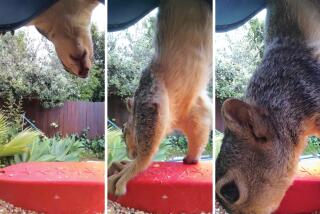How do squirrels think? This Berkeley lab is studying the revered campus rodent to find out
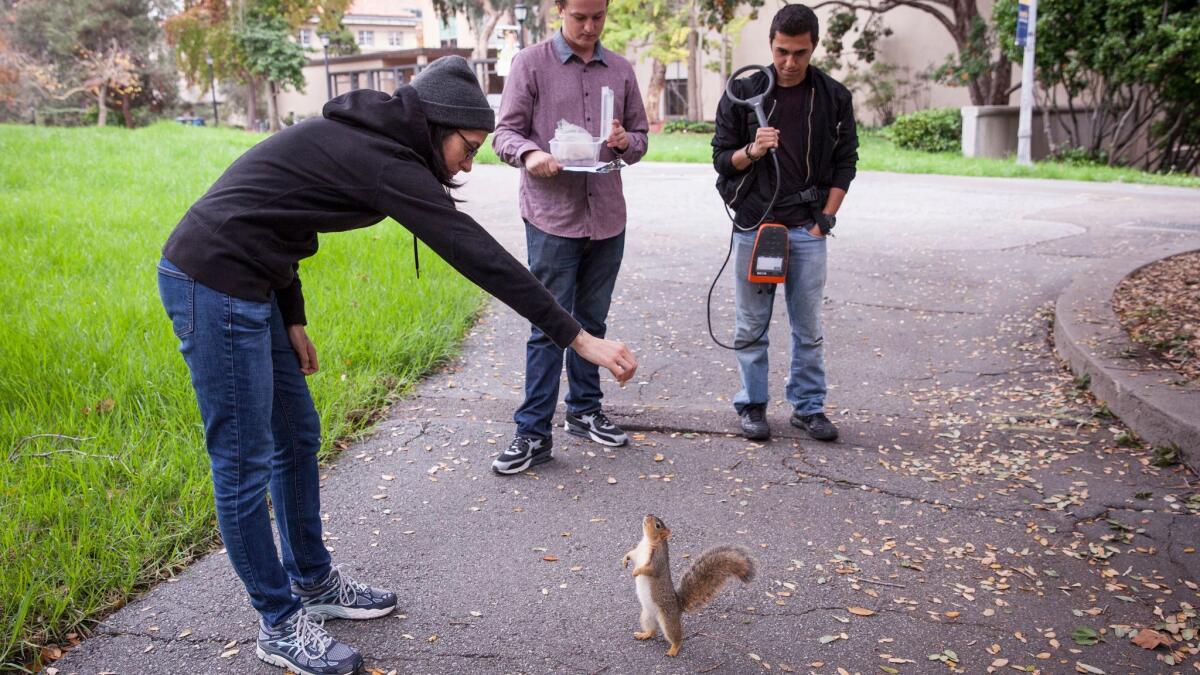
- Share via
Reporting from Berkeley — On a recent day, three UC Berkeley researchers scanned the leaf-strewn campus hunting for treasures.
They were armed with equipment that looked like metal detectors, but their quarry wasn’t dropped coins or jewelry. Doctoral student Mikel Delgado and her team were searching for hazelnuts they’d embedded with microchips to help them answer the question: How do squirrels decide where to bury their nuts?
“Got one!” called out Aryan Sharif, a senior studying ecology, as a number popped up on his microchip reader. Daniel Petrie, a research assistant, clipboard in hand, recorded that 5D49, buried by a squirrel nine months earlier, remained just where it had been, undisturbed.
Squirrels are so ubiquitous, they’re easy to ignore. But Delgado and others at the Jacobs Lab for Cognitive Biology say they’re more than bright-eyed and bushy-tailed; they’re brainy enough to deserve a close look.
The rodents have figured out how to survive for millions of years, adapting on five continents to diverse terrain including tropical rainforests and semiarid deserts. They like nuts and seeds, but they’ll eat bird eggs, tree bark, insects — and, at Berkeley anyway, French fries and chocolate.
They are relentless robbers of seeds from bird feeders, deftly defying attempts to deter them, as recorded in countless home videos and even a British documentary, “Daylight Robbery.” Lab founder Lucia Jacobs has been able to document that squirrels remember where they hide their nuts — no small feat, considering experts estimate each squirrel could stash as many as 10,000 a year. Researchers believe squirrels use large landmarks to narrow down their search and probably use smell and trial-and-error to find them. When they think competitors are spying, they’ll even stage fake burials — digging a hole and pretending to drop a nut in it while hiding the loot in their mouths.
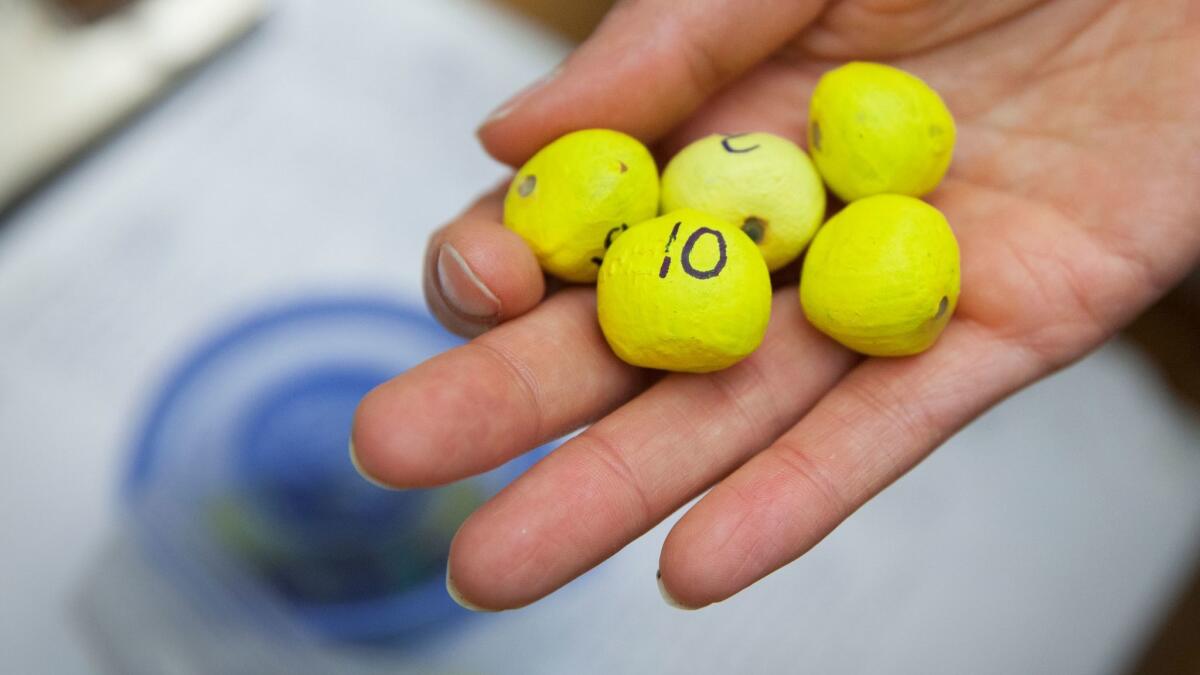
All of which drew Delgado, a punk-rock bass guitar player and lifelong animal lover, to devote herself to studying them at Berkeley for her psychology doctorate. The campus is an outdoor laboratory of hundreds of tree-dwelling fox squirrels, so popular that they’ve inspired coverage by student journalists and their own Facebook page, Berkeley Squirrels. One Daily Californian article compared them to freshmen in their typical winter weight gain and endless search for free food.
“You could probably study squirrels for 20 years and still have questions,” Delgado said. “They’re fun to study. They’re gregarious. They tease dogs. They’ve found a niche in this very unnatural urban environment and have thrived in it.”
For her dissertation, titled “Cache decisions, competition and cognition in the fox squirrel,” Delgado is exploring where squirrels bury their nuts, how long those nuts stay buried and whether they get moved or stolen. Her work, which she began in 2014, is supported by a $20,000 National Science Foundation grant, which enabled her to purchase the microchip reader and pay for research assistance.
One line of inquiry is whether squirrels who are related bury their caches close to one another’s to promote their group survival. Another is the effect that having their nuts stolen has on squirrels’ long-term memory. She has yet to reach firm conclusions, although findings from computer simulations suggest that squirrels whose nuts are frequently pilfered may have shorter memories, because they have less need to remember their cache locations.
As Delgado strolls the campus, making clicking noises, squirrels bound toward her and stand on their hind legs to catch nuts she drops into their paws. She knows many of them, as they know her. Flame, easily identified by a crooked tooth, comes running. She’s “a badass mama squirrel” who is known for chasing competitors away when they get too close to her nuts, Delgado says.
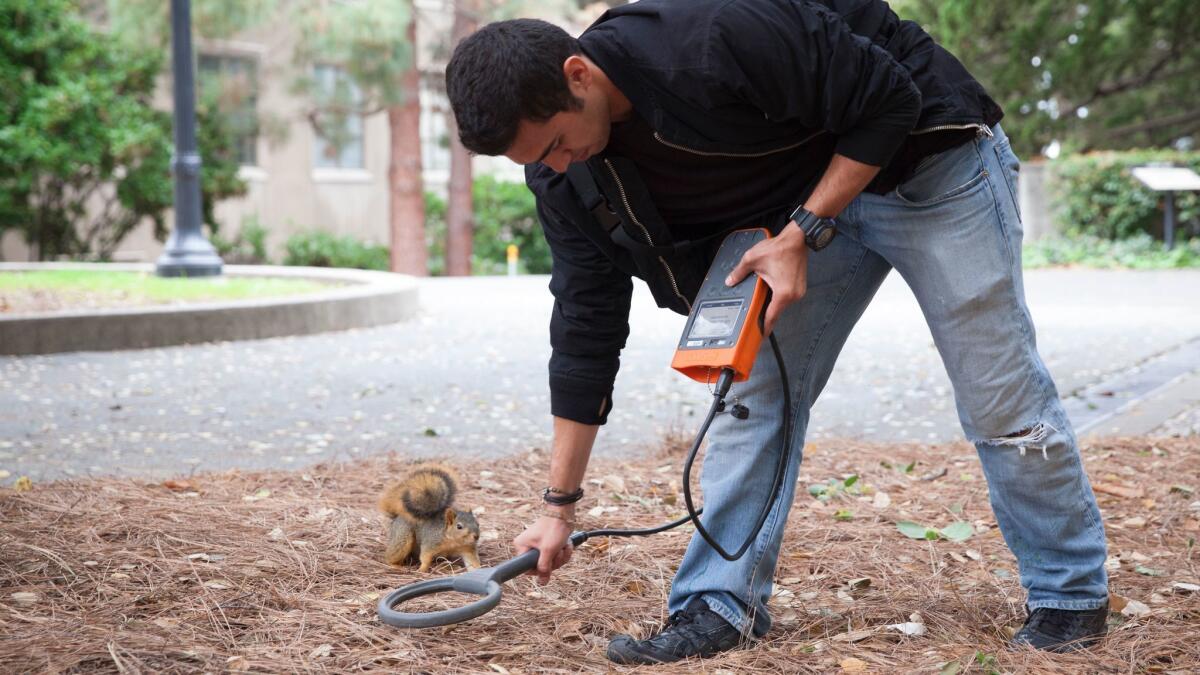
Her research team lures the squirrels with the nuts, then sprays the animals for tracking purposes with a nontoxic dye. Each is given a name: Flame, Autumn, Cookie, Britney Spears. The team collects data between moltings in order to keep the squirrels straight.
Delgado gave 350 nuts to Flame in 2014 and 300 nuts to 21 squirrels last year to monitor where they buried them and what happened afterward. An initial attempt to tag the nuts failed because the squirrels kept chewing off the tags. So Delgado moved to the microchips, thin cylinders as long as a thumbnail, slipping them into holes drilled in the nuts.
To test the question of how related squirrels behaved, Delgado lured nearly two dozen squirrels though a tunnel lined with double-sided tape and collected the tail hair stuck to it. She and another researcher are working with Berkeley’s Evolutionary Genetics Lab to analyze the DNA.
The Jacobs Lab’s work on squirrels is helping scientists understand how animals exploit complex environments to survive, said John Koprowski, a University of Arizona professor of wildlife conservation and management.
“Often humans view animals as not being as adept at handling challenges they face and don’t have an appreciation for their incredible complexity,” he said. “The work at Berkeley enables us to look at the psychology, sensory abilities and learning of squirrels to find resources and deal with a complex, 3-D environment.”
Delgado, 45, hardly expected to find herself studying squirrels. She’s a cat lover who grew up in Maine and dropped out of college there at 21 to join the punk-rock scene in San Francisco. She started a band, the Cinnamon Imperials, began working at a health food co-op and volunteered at the Society for the Prevention of Cruelty to Animals. Eventually, the SPCA gave her a job as a cat behavior specialist who socialized shelter cats to prepare them for adoption.
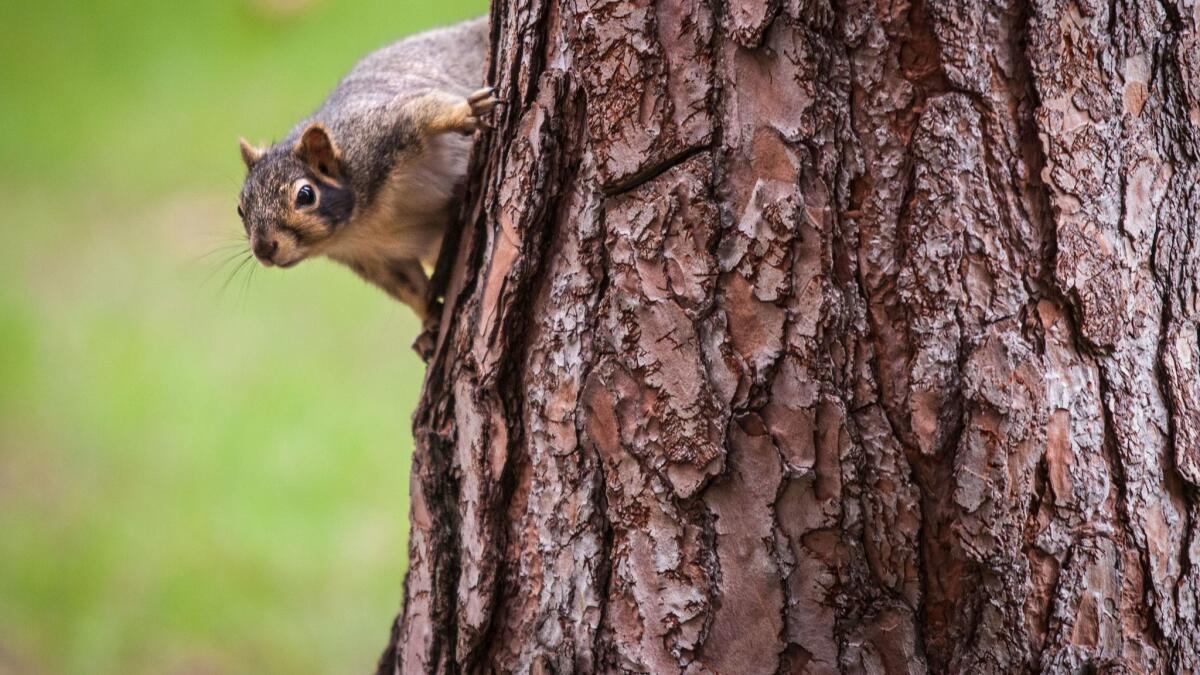
She returned to school at Cal State East Bay, where she majored in psychology and worked in a lab with pigeons and zebrafish. By graduation, she’d gotten very interested in animal behavior, though not in those animals in particular.
“I loved the birds and the fish, but I wanted to do something a little fuzzier,” she said.
Delgado, a Mexican American, was recruited to the federally funded McNair Scholars Program, which seeks to prepare underrepresented minorities and first-generation college students for doctoral studies. She considered programs with pigeons at Cornell University and cats at Washington State University and the University of Nebraska. But Berkeley had Jacobs, a top-notch doctoral advisor, and the best financial package — a $24,000 annual stipend that allowed her to focus on her research, without teaching, for two years.
Today, Delgado splits her affections. Her Tolman Hall office is decorated with squirrel paraphernalia — squirrel-sized underpants, a squirrel nutcracker, squirrel cookie cutters. But she also has two pet cats and a tattoo on her leg in memory of Kittums, the grey and white tabby who made the trek with her from Maine.
In her free time, on her blog catsandsquirrels.com, she chronicles the exploits of squirrels — stealing Christmas bulbs, getting stuck in manholes — and reports on the perils of feline pudginess. She also co-runs a cat consulting business.
On track to finish her dissertation this fall, she is applying for various jobs, including postdoctoral and faculty positions. She isn’t sure she’ll continue to study squirrels — but she’s certain, based on her observations, that they’ll continue to thrive.
“Even if we disappear, squirrels will keep doing what they’ve been doing for millions of years,” she said.
To read the article in Spanish, click here
More to Read
Sign up for Essential California
The most important California stories and recommendations in your inbox every morning.
You may occasionally receive promotional content from the Los Angeles Times.


